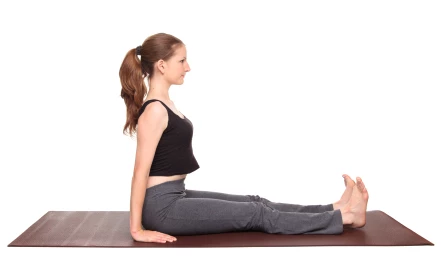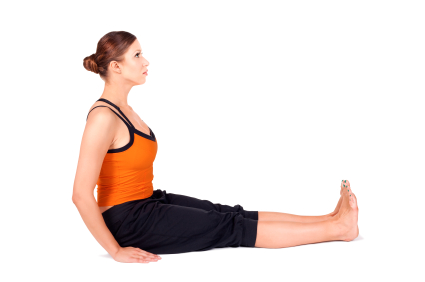Building Core Strength with Staff Pose

Staff Pose (Dandasana) is a great core-strengthening seated yoga pose, which, for the most part, doesn’t get the billing it deserves.
In this article, you’ll learn about:
- Benefits of Dandasana
- How to Practice Dandasana
- Common Alignment Issues
- Teaching Yoga to Beginners: Dandasana Modifications
Benefits of Staff Pose (Dandasana)
- Strengthens all the major core muscles
- Improves posture and back health
- Increases strength and stamina
Like so many yoga postures, Dandasana may appear simple. However, unless you already have great core strength, you’ll find that it quickly becomes a very demanding yoga pose!
How to Practice Staff Pose
- Sit on your mat with your legs extended out in front of you. Use your hands to pull the flesh of the buttocks back and away from the ischial tuberosities (sit bones), so you feel yourself sitting more directly on the sit bones.
- Take a strap and loop it around the ball of your foot. Holding on to each end of the strap with each of your hands, flex your feet and gently pull back the strap till it tightens. Use the strap to pull your chest gently forward and elongate the spine. Keep your elbows close to your torso, don’t let them jut out.
- Firm your thighs and rotate them gently toward each other, keeping the feet flexed. Keep elongating the spine. Mentally press the sit bones into the floor as you keep lengthening the spine, visualizing a pull upward from the crown of your head, and a grounding downward through your sit bones.
- Draw your shoulder blades gently together in the back, further lifting your heart center. Breathe deeply and calmly as you hold the posture, ideally for 3 to 5 minutes. Then release and relax.
Common Alignment Issues: Flattening or Rounding the Low Back

As you get stronger, begin to do Seated Staff Pose without using the strap. Don’t let go of the strap too early, though, as losing the full lumbar curve in the lower back will be counter-productive and could hurt your back rather than strengthen it. As illustrated in the picture to the right, it is easy to lose correct alignment, even a flat lower back (as opposed to the full lumbar curve in the photo above) will not give you the benefit of this pose. Like for many yoga poses, in Dandasana it’s critical to honestly assess your body’s limitations and try not to push beyond that.
Teaching Yoga to Beginners: Dandasana Modifications
For people with tight hamstrings, this can be a particularly challenging seated yoga pose, as the hamstrings will tend to pull your pelvis under, rounding the lower back.
Try this Dandasana variation to avoid it:
- Sit on the forward edge of a cushion, so that you your pelvis tilts forward, and you have a full concave curve in the lumbar spine while doing the pose.
Seated Staff Pose can be great as part of a regular yoga practice. If you’re looking to do core strengthening outside your practice, this can be a great pose to sit in while you’re watching TV, listening to music, and so on. Naturally, you’ll get the most benefits from the pose if you don’t have an external focus while practicing Dandasana. Allow your mind to stay present with your body.



